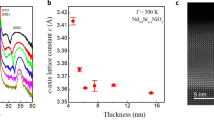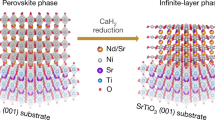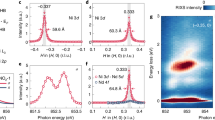Abstract
Nickel-based superconductors provide a long-awaited experimental platform to explore possible cuprate-like superconductivity. Despite similar crystal structure and d electron filling, however, superconductivity in nickelates has thus far only been stabilized in thin-film geometry, raising questions about the polar interface between substrate and thin film. Here we conduct a detailed experimental and theoretical study of the prototypical interface between Nd1−xSrxNiO2 and SrTiO3. Atomic-resolution electron energy loss spectroscopy in the scanning transmission electron microscope reveals the formation of a single intermediate Nd(Ti,Ni)O3 layer. Density functional theory calculations with a Hubbard U term show how the observed structure alleviates the polar discontinuity. We explore the effects of oxygen occupancy, hole doping and cation structure to disentangle the contributions of each for reducing interface charge density. Resolving the non-trivial interface structure will be instructive for future synthesis of nickelate films on other substrates and in vertical heterostructures.
This is a preview of subscription content, access via your institution
Access options
Access Nature and 54 other Nature Portfolio journals
Get Nature+, our best-value online-access subscription
$29.99 / 30 days
cancel any time
Subscribe to this journal
Receive 12 print issues and online access
$259.00 per year
only $21.58 per issue
Buy this article
- Purchase on Springer Link
- Instant access to full article PDF
Prices may be subject to local taxes which are calculated during checkout






Similar content being viewed by others
Data availability
The experimental data relevant to the findings of this paper have been deposited in the Platform for the Accelerated Realization, Analysis, and Discovery of Interface Materials (PARADIM) database at https://doi.org/10.34863/nf7t-jj61. Additional data, including that contained in Supplementary Information and results of the DFT + U calculations, are available upon reasonable request to the authors.
References
Li, D. et al. Superconductivity in an infinite-layer nickelate. Nature 572, 624–627 (2019).
Zeng, S. et al. Phase diagram and superconducting dome of infinite-layer Nd1−xSrxNiO2 thin films. Phys. Rev. Lett. 125, 147003 (2020).
Gu, Q. et al. Single particle tunneling spectrum of superconducting Nd1−xSrxNiO2 thin films. Nat. Commun. 11, 6027 (2020).
Osada, M. et al. A superconducting praseodymium nickelate with infinite layer structure. Nano Lett. 20, 5735–5740 (2020).
Zeng, S. et al. Superconductivity in infinite-layer nickelate La1−xCaxNiO2 thin films. Sci. Adv. 8, eabl9927 (2022).
Osada, M. et al. Nickelate superconductivity without rare-earth magnetism: (La,Sr)NiO2. Adv. Mater. 33, 2104083 (2021).
Gao, Q., Zhao, Y., Zhou, X. & Zhu, Z. Preparation of superconducting thin films of infinite-layer nickelate Nd0.8Sr0.2NiO2. Chin. Phys. Lett. 38, 077401 (2021).
Hepting, M. et al. Electronic structure of the parent compound of superconducting infinite-layer nickelates. Nat. Mater. 19, 381–385 (2020).
Goodge, B. H. et al. Doping evolution of the Mott–Hubbard landscape in infinite-layer nickelates. Proc. Natl Acad. Sci. USA 118, e2007683118 (2021).
Bernardini, F. & Cano, A. Stability and electronic properties of LaNiO2/SrTiO3 heterostructures. J. Phys. Mater. 3, 03LT01 (2020).
Geisler, B. & Pentcheva, R. Fundamental difference in the electronic reconstruction of infinite-layer versus perovskite neodymium nickelate films on SrTiO3 (001). Phys. Rev. B 102, 020502 (2020).
Bednorz, J. G. & Müller, K. A. Possible high Tc superconductivity in the Ba-La-Cu-O system. Z. Phys. B Condens. Matter 64, 189–193 (1986).
Wu, M.-K. et al. Superconductivity at 93 K in a new mixed-phase Y-Ba-Cu-O compound system at ambient pressure. Phys. Rev. Lett. 58, 908 (1987).
Maeda, H., Tanaka, Y., Fukutomi, M. & Asano, T. A new high-Tc oxide superconductor without a rare earth element. Jpn. J. Appl. Phys. 27, L209 (1988).
Sheng, Z. & Hermann, A. Bulk superconductivity at 120 K in the Tl–Ca/Ba–Cu–O system. Nature 332, 138–139 (1988).
Schilling, A., Cantoni, M., Guo, J. & Ott, H. Superconductivity above 130 K in the Hg–Ba–Ca–Cu–O system. Nature 363, 56–58 (1993).
Pan, G. A. et al. Superconductivity in a quintuple-layer square-planar nickelate. Nat. Mater. 21, 160–164 (2022).
Ren, X. et al. Strain-induced enhancement of Tc in infinite-layer Pr0.8Sr0.2NiO2 films. Preprint at https://arxiv.org/abs/2109.05761 (2022).
Lee, K. et al. Aspects of the synthesis of thin film superconducting infinite-layer nickelates. APL Mater. 8, 041107 (2020).
Puphal, P. et al. Topotactic transformation of single crystals: from perovskite to infinite-layer nickelates. Sci. Adv. 7, eabl8091 (2021).
Zhang, Y. et al. Similarities and differences between nickelate and cuprate films grown on a SrTiO3 substrate. Phys. Rev. B 102, 195117 (2020).
He, R. et al. Polarity-induced electronic and atomic reconstruction at NdNiO2/SrTiO3 interfaces. Phys. Rev. B 102, 035118 (2020).
Geisler, B. & Pentcheva, R. Correlated interface electron gas in infinite-layer nickelate versus cuprate films on SrTiO3 (001). Phys. Rev. Res. 3, 013261 (2021).
Mundy, J. A. et al. Visualizing the interfacial evolution from charge compensation to metallic screening across the manganite metal–insulator transition. Nat. Commun. 5, 3464 (2014).
Ohtomo, A. & Hwang, H. Y. A high-mobility electron gas at the LaAlO3/SrTiO3 heterointerface. Nature 427, 423–426 (2004).
Reyren, N. et al. Superconducting interfaces between insulating oxides. Science 317, 1196–1199 (2007).
Lee, K. et al. Character of the “normal state” of the nickelate superconductors. Preprint at https://arxiv.org/abs/2203.02580 (2022).
Botana, A. S., Bernardini, F. & Cano, A. Nickelate superconductors: an ongoing dialog between theory and experiments. J. Exp. Theor. Phys. 132, 618–627 (2021).
Nakagawa, N., Hwang, H. Y. & Muller, D. A. Why some interfaces cannot be sharp. Nat. Mater. 5, 204–209 (2006).
Kourkoutis, L. F., Muller, D., Hotta, Y. & Hwang, H. Asymmetric interface profiles in LaVO3/SrTiO3 heterostructures grown by pulsed laser deposition. Appl. Phys. Lett. 91, 163101 (2007).
Kourkoutis, L. F., Song, J., Hwang, H. & Muller, D. Microscopic origins for stabilizing room-temperature ferromagnetism in ultrathin manganite layers. Proc. Natl Acad. Sci. USA 107, 11682–11685 (2010).
Egerton, R. Oscillator-strength parameterization of inner-shell cross sections. Ultramicroscopy 50, 13–28 (1993).
Ohtomo, A., Muller, D. A., Grazul, J. L. & Hwang, H. Y. Artificial charge-modulation in atomic-scale perovskite titanate superlattices. Nature 419, 378–380 (2002).
Zhou, X.-R. et al. Negligible oxygen vacancies, low critical current density, electric-field modulation, in-plane anisotropic and high-field transport of a superconducting Nd0.8Sr0.2NiO2/SrTiO3 heterostructure. Rare Metals 40, 2847–2854 (2021).
Sahinovic, A. & Geisler, B. Active learning and element embedding approach in neural networks for infinite-layer versus perovskite oxides. Phys. Rev. Res. 3, L042022 (2021).
de Groot, F. M. F. et al. Oxygen 1s x-ray-absorption edges of transition-metal oxides. Phys. Rev. B 40, 5715–5723 (1989).
Kourkoutis, L. F. et al. Atomic-resolution spectroscopic imaging of oxide interfaces. Philos. Mag. 90, 4731–4749 (2010).
De Groot, F. et al. Oxygen 1s x-ray absorption of tetravalent titanium oxides: a comparison with single-particle calculations. Phys. Rev. B 48, 2074 (1993).
Suntivich, J. et al. Estimating hybridization of transition metal and oxygen states in perovskites from O K-edge X-ray absorption spectroscopy. J. Phys. Chem. C 118, 1856–1863 (2014).
Frati, F., Hunault, M. O. & De Groot, F. M. Oxygen k-edge X-ray absorption spectra. Chem. Rev. 120, 4056–4110 (2020).
Li, D. et al. Superconducting dome in Nd1−xSrxNiO2 infinite layer films. Phys. Rev. Lett. 125, 027001 (2020).
Zeng, S. et al. Observation of perfect diamagnetism and interfacial effect on the electronic structures in infinite layer Nd0.8Sr0.2NiO2 superconductors. Nat. Commun. 13, 743 (2022).
Lu, H. et al. Magnetic excitations in infinite-layer nickelates. Science 373, 213–216 (2021).
Rossi, M. et al. A broken translational symmetry state in an infinite-layer nickelate. Nat. Phys. 18, 869–873 (2022).
Krieger, G. et al. Charge and spin order dichotomy in NdNiO2 driven by the capping layer. Phys. Rev. Lett. 129, 027002 (2022).
Tam, C. C. et al. Charge density waves in infinite-layer NdNiO2 nickelates. Nat. Mater. 21, 1116–1120 (2022).
Ruf, J. P. et al. Strain-stabilized superconductivity. Nat. Commun. 12, 59 (2021).
Hicks, C. W. et al. Strong increase of Tc of Sr2RuO4 under both tensile and compressive strain. Science 344, 283–285 (2014).
Steppke, A. et al. Strong peak in Tc of Sr2RuO4 under uniaxial pressure. Science 355, eaaf9398 (2017).
Nair, H. P. et al. Demystifying the growth of superconducting Sr2RuO4 thin films. APL Mater. 6, 101108 (2018).
Wang, N. N. et al. Pressure-induced monotonic enhancement of Tc to over 30 K in the superconducting Pr0.82Sr0.18NiO2 thin films. Nat. Commun. 13, 4367 (2022).
Ortiz, R. A. et al. Superlattice approach to doping infinite-layer nickelates. Phys. Rev. B 104, 165137 (2021).
Lippmaa, M. et al. Observation of SrTiO3 step edge dynamics by real-time high-temperature STM. Appl. Surf. Sci. 130, 582–586 (1998).
Nishimura, T., Ikeda, A., Namba, H., Morishita, T. & Kido, Y. Structure change of TiO2-terminated SrTiO3 (001) surfaces by annealing in O2 atmosphere and ultrahigh vacuum. Surf. Sci. 421, 273–278 (1999).
Goodge, B. H., Bianco, E., Schnitzer, N., Zandbergen, H. W. & Kourkoutis, L. F. Atomic-resolution cryo-STEM across continuously variable temperatures. Microsc. Microanal. 26, 439–446 (2020).
Savitzky, B. H. et al. Image registration of low signal-to-noise cryo-stem data. Ultramicroscopy 191, 56–65 (2018).
Stetson, P. B. Daophot: a computer program for crowded-field stellar photometry. Publ. Astron. Soc. Pac. 99, 191 (1987).
Kohn, W. & Sham, L. J. Self-consistent equations including exchange and correlation effects. Phys. Rev. 140, A1133 (1965).
Giannozzi, P. et al. QUANTUM ESPRESSO: a modular and open-source software project for quantum simulations of materials. J. Phys. Condens. Matter 21, 395502 (2009).
Perdew, J. P., Burke, K. & Ernzerhof, M. Generalized gradient approximation made simple. Phys. Rev. Lett. 77, 3865 (1996).
Anisimov, V. I., Solovyev, I., Korotin, M., Czyżyk, M. & Sawatzky, G. Density-functional theory and NiO photoemission spectra. Phys. Rev. B 48, 16929 (1993).
Cococcioni, M. & De Gironcoli, S. Linear response approach to the calculation of the effective interaction parameters in the LDA + U method. Phys. Rev. B 71, 035105 (2005).
Liu, J. et al. Heterointerface engineered electronic and magnetic phases of NdNiO3 thin films. Nat. Commun. 4, 2714 (2013).
Botana, A. A. & Norman, M. R. Similarities and differences between infinite-layer nickelates and cuprates and implications for superconductivity. Phys. Rev. X 10, 011024 (2020).
Vanderbilt, D. Soft self-consistent pseudopotentials in a generalized eigenvalue formalism. Phys. Rev. B 41, 7892 (1990).
Blöchl, P. E. Projector augmented-wave method. Phys. Rev. B 50, 17953 (1994).
Nomura, Y. et al. Formation of a two-dimensional single-component correlated electron system and band engineering in the nickelate superconductor NdNiO2. Phys. Rev. B 100, 205138 (2019).
Lechermann, F. Late transition metal oxides with infinite-layer structure: nickelates versus cuprates. Phys. Rev. B 101, 081110 (2020).
Monkhorst, H. J. & Pack, J. D. Special points for Brillouin-zone integrations. Phys. Rev. B 13, 5188 (1976).
Methfessel, M. & Paxton, A. High-precision sampling for Brillouin-zone integration in metals. Phys. Rev. B 40, 3616 (1989).
Acknowledgements
B.H.G. and L.F.K. acknowledge support from the Department of Defense Air Force Office of Scientific Research (FA 9550-16-1-0305; L.F.K.) and the Packard Foundation. This work made use of the Cornell Center for Materials Research Shared Facilities, which are supported through the NSF MRSEC Program (DMR-1719875; L.F.K.). The FEI Titan Themis 300 was acquired with support from NSF (NSF-MRI-1429155; L.F.K.), with additional support from Cornell University, the Weill Institute and the Kavli Institute at Cornell. The Thermo Fisher Helios G4 UX focused ion beam was acquired with support from the National Science Foundation Platform for Accelerated Realization, Analysis, and Discovery of Interface Materials (Cooperative Agreement DMR-1539918; L.F.K.). B.G. and R.P. acknowledge support from the German Research Foundation (DFG) within CRC/TRR 80 (107745057; R.P.). Projects G3 and G8 and computational time at magnitUDE were granted by the Center for Computational Sciences and Simulation of the University of Duisburg-Essen (DFG Grant INST 20876/209-1 FUGG; R.P.). The work at SLAC/Stanford is supported by the US Department of Energy, Office of Basic Energy Sciences, Division of Materials Sciences and Engineering (DE-AC02-76SF00515; H.Y.H.) and the Gordon and Betty Moore Foundation’s Emergent Phenomena in Quantum Systems Initiative (GBMF9072 for synthesis equipment; H.Y.H.). M.O. acknowledges partial financial support from the Takenaka Scholarship Foundation.
Author information
Authors and Affiliations
Contributions
B.H.G. and L.F.K. conceived of the project. L.F.K., R.P. and H.Y.H. supervised the research. B.H.G. and L.F.K. performed the electron microscopy, electron energy loss spectroscopy and corresponding data analysis. B.G. and R.P. performed the theoretical calculations and corresponding analysis. D.L. and M.O. grew and reduced the nickelate films. K.L., D.L., M.O. and B.Y.W. conducted materials and structural characterization. B.H.G., L.F.K., B.G. and R.P. wrote the paper. All authors discussed the results and revised the paper.
Corresponding authors
Ethics declarations
Competing interests
The authors declare no competing interests.
Peer review
Peer review information
Nature Materials thanks the anonymous reviewers for their contribution to the peer review of this work.
Additional information
Publisher’s note Springer Nature remains neutral with regard to jurisdictional claims in published maps and institutional affiliations.
Supplementary information
Supplementary Information
Supplementary Figs. 1–15.
Rights and permissions
Springer Nature or its licensor (e.g. a society or other partner) holds exclusive rights to this article under a publishing agreement with the author(s) or other rightsholder(s); author self-archiving of the accepted manuscript version of this article is solely governed by the terms of such publishing agreement and applicable law.
About this article
Cite this article
Goodge, B.H., Geisler, B., Lee, K. et al. Resolving the polar interface of infinite-layer nickelate thin films. Nat. Mater. 22, 466–473 (2023). https://doi.org/10.1038/s41563-023-01510-7
Received:
Accepted:
Published:
Issue Date:
DOI: https://doi.org/10.1038/s41563-023-01510-7
This article is cited by
-
Direct observation of strong surface reconstruction in partially reduced nickelate films
Nature Communications (2024)
-
Structural transitions, octahedral rotations, and electronic properties of A3Ni2O7 rare-earth nickelates under high pressure
npj Quantum Materials (2024)



